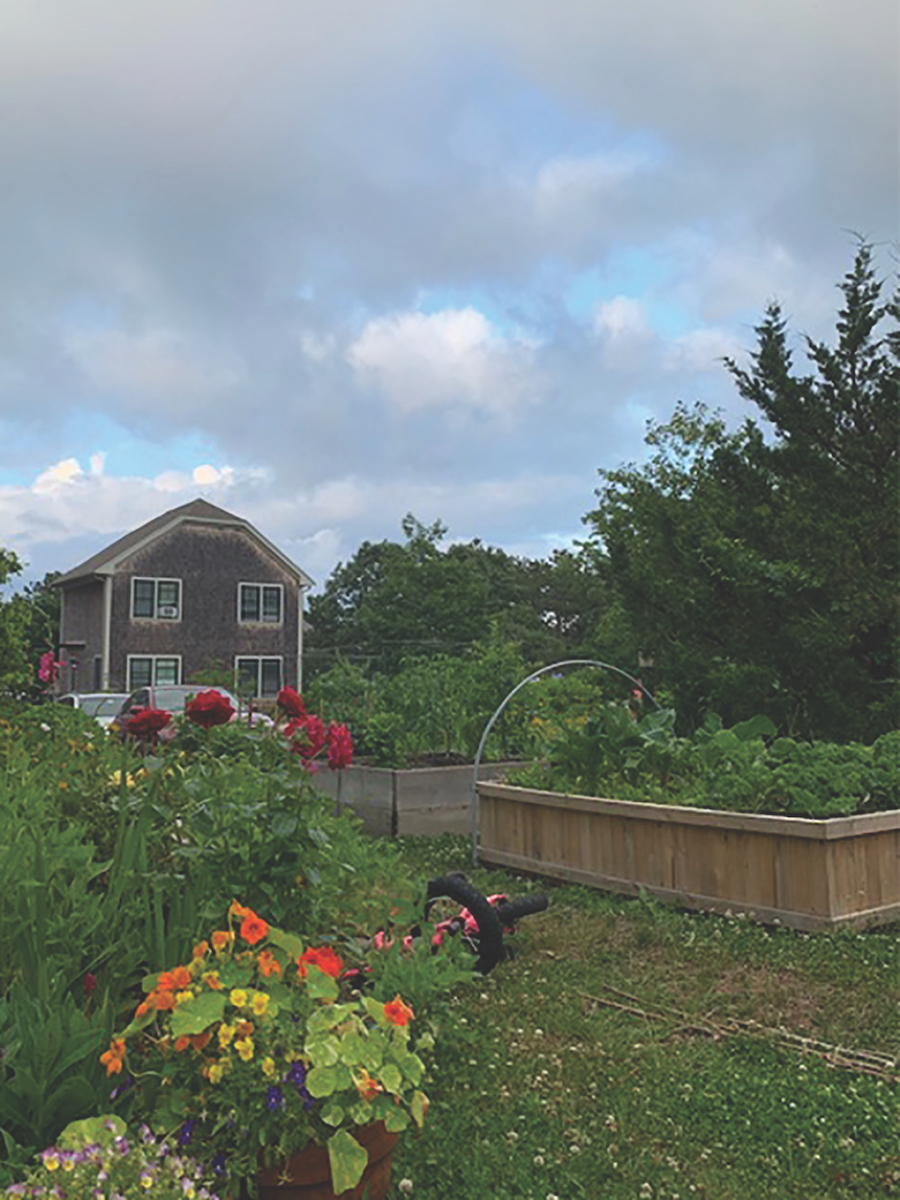TRURO — Janice Sommers and Janice Walk have called Sally’s Way home from its beginnings — going back to 2012 when Truro’s long-awaited affordable housing development was just a sandy construction lot overlooking the Truro Public Library. Like many working year-rounders, Sommers and Walk had roots on the Outer Cape, but faced difficulties finding affordable housing. For them, the place provides more than affordability: it’s a neighborhood that’s supportive — and that’s been especially important in this time of Covid-19.

Sommers and Walk, artists who have been together since 1992, met in Provincetown, where Walk had lived since she was 21. A brief stint living in Florida while caring for Walk’s parents, and the housing crash of 2008, cost them their Provincetown house, and while the couple didn’t want to leave the place they both considered home, by 2011 they seemed to be at a dead end.
Construction began at Sally’s Way in December 2012. The project had by then been 12 years in the making, but the timing happened to work for the couple. “We would sit in the library parking lot while construction was going on, and figure out which house we wanted up here,” recalled Sommers.
Looping around a cul-de-sac on a breezy hill, the neighborhood is characterized by Cape-y cedar-shingled cottages. A path through the trees behind the library leads to the Children’s Community Garden, where neighborhood kids are learning to care for plants.
Affordable housing developer Ted Malone, whose company, Community Housing Resource (CHR), built Sally’s Way, is pleased with the outcome.
“We’ve been recognized for creating very livable communities that people would look at and never figure were affordable housing,” he said, “and never would figure were as new as they are.”

Named after Sally Sears-Mack, an advocate for affordable housing on the Outer Cape, Sally’s Way began to take shape in the year 2000 as a component of a master plan for development of a 10.66-acre site acquired through a tax title taking. Its 16 units were officially completed on Sept. 20, 2013.
The long time frame to completion was due to a lawsuit by neighbors who were owners of Babe’s Bakery, according to Malone. That business was at the time located on Shore Road.
“We were committed to fight it out in court,” said Malone. “It delayed us just about five years. We lost some funding reservations, but fortunately we were able to reassemble funding for the development.”
Susan Kadar, who served on the Truro Housing Authority during the time Sally’s Way was in the making, said the concerns were about drinking water and wastewater. “They were not real problems,” she said, “but when cases end up in land court, they can take forever to resolve.
“There is nothing more frustrating and discouraging than working on affordable housing in Truro,” Kadar added, “but every now and then, when there is a victory, to see families move in and not have to move out for summer is enormously rewarding.”
In multiple interviews with residents, only one criticism of Sally’s Way emerged. “To truly open up the realm of affordable housing to a larger demographic,” said Sommers, “more units need to be designed for people with disabilities.” Out of 16 units, Sally’s Way offers only one handicapped-accessible unit. “Buildings need to be built around the idea that people are different.”
Residents agree that they appreciate the quality of their homes. But more often they make the point that the neighborhood’s success lies in the tight-knit sense of community that it has facilitated.
Sally’s Way resident Krista Edwards works at the Sheraton Hotel in Eastham. Her husband works for the highway dept. in Provincetown. “So many of our friends have had to leave because they couldn’t afford housing,” Krista said. “There’s just not enough housing here.”
Edwards appreciates the child-friendliness of the neighborhood. “We used to live in an apartment,” she said, where neighboring seniors were unhappy that families with children were renting. “They’d file noise complaints even when the kids were quiet, and didn’t say hello,” she recalled. “Now we come home and there are five cupcakes on the porch, left for the kids by one of the neighbors.”
The harmony of the neighborhood isn’t entirely a product of luck, said resident Sarah Naciri. “When you put affordable housing in a place,” she said, “you’re intentionally creating a community.” She credits CHR with “creating a neighborhood with safe, kind, caring people.”
In addition to a lottery system for applicants, CHR screens residents and requires several interviews. “They do a really great job of trying to match people,” said Krista Edwards.
“They help people live next door to each other who can actually get along,” said two-year resident Kelli Costa. “The interview process makes sure everyone is a good fit.”
The residents of Sally’s Way disagree with some of the Covid-19-related concerns that have been raised about the proposed Cloverleaf project: namely, that the close nature of units in affordable housing will facilitate the virus’s spread.
The proximity of neighbors actually allows for a healthier pandemic response, said Sarah Naciri. “We help each other with shopping,” she said. Thanks to the neighborhood group chat, shopping trips are consolidated and limit the risk of infection. And, said Edwards, “We keep our distance, but just not being alone during a pandemic is so important.”
“To really know your neighbors,” said Naciri, “is a profoundly healing experience.” Costa agreed: “I’m a massage therapist, Genevieve is a yoga instructor, Sarah is an herbalist. I look at this place like a healing village.”
Edwards wasn’t sure they’d stay long at Sally’s Way. The surprise, she said, is that she has ended up “totally falling in love with it. This is home, and we’re just so happy here.”
